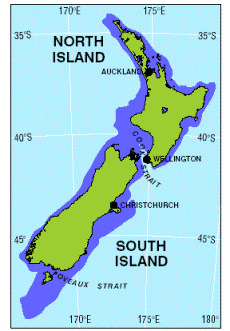Dating the Moutere aquifer
Paleogroundwater in the Moutere Gravel Aquifers near Nelson, New Zealand
Radiocarbon, oxygen-18 and chemical concentrations have been used to investigate the history of groundwater in Moutere Gravel aquifers near Nelson (Fig.1). Groundwater flow in aquifers occurs in response to hydraulic gradients between their recharge and discharge areas. Strong climatic fluctuations in the Quaternary caused repeated rise and fall of sea level, leading to drastic effects on groundwater flow in aquifers. In particular, the rapid rise of sea level (around 10,000 years BP) after the last glacial maximum at 18,000 years BP (Fig. 2) is likely to have trapped "paleo" waters at deeper levels in coastal aquifers. We have identified such paleowater in the deepest Moutere Gravel aquifer.
Moutere Gravel underlies most of the Moutere Depression, a 30 km-wide system of valleys extending northwards into Tasman Bay and Cook Strait. Voluminous Plio-Pleistocene gravels (principally Moutere Gravel) are preserved in the depression and have been incised by the Motueka, Moutere and Waimea rivers. During the last glacial episode, Cook Strait was bridged by a huge plain connecting the North and South Islands of New Zealand, and the nearest sea would have been hundreds of km from the present Nelson Coast.
 |
 |
Fig. 1 - Study area |
Fig. 2 Last ice-age map of New Zealand |
Bores up to 500 m deep tap aquifers underlying the Motueka-Nelson area. The bores are cased for the first 40-50 m, but are then open holes, giving rise to mixing of water from different depths. The tendency is for aquifer permeabilities and artesian heads to increase with depth allowing deeper water to contribute strongly. Shallow bores (50-100 m) tap "modern" or "pre-industrial" water with carbon-14 concentrations of 90 ± 10 pmC. Their d18O values are -6.8 ± 0.4‰, as expected for present-day rainfall. Deeper bores discharge water with lower 14C concentrations and more negative d18O values resulting from input of older water from depth. The deep end-member of the mixing trend is identified as paleowater with 14C concentration close to 0 pmC and more negative d18O (-7.6‰). Mixing of modern and paleowaters gives rise to variations observed in the oxygen-18, carbon-14 and chemical concentrations of the bore waters. The chemical characteristics of the paleowater have been determined as end members on mixing plots between chemical components and d18O.
Identification of the deep groundwater as paleowater suggests that there may be a large body of such water onshore and offshore. Its nature and disposition gives information on conditions during the late Quaternary (e.g. has recharge been continuous or discontinuous, and what factors have affected the d18O value). The water is pristine, in the sense of being free of modern contaminants, and consideration should be given to its value and preservation.
The full report: "Moutere Valley Groundwater: Nature and Recharge from Isotopes and Chemistry". M.K. Stewart and J.T. Thomas, IGNS Science Report 2002/22 (![]() 1269kb)
1269kb)
Note: This report was done as part of the IGNS Research programme "Understanding Groundwater" (not the ICM -Motueka Programme).
Press Release on this work
"Scientists studying an aquifer in the Nelson-Motueka area have found what they believe is the oldest fresh water in New Zealand.
The Moutere aquifer contains high quality glacial-age water more than 20,000 years old, said groundwater scientist Mike Stewart of GNS (Geological and Nuclear Sciences Ltd).
The aquifer, which is 400m to 500m deep, contains a large body of water which probably extends offshore into Tasman Bay.
"We were surprised to find fresh water of this age. There are also relatively old groundwaters in deep aquifers in Manawatu, Taranaki and Canterbury," Dr Stewart said.
The Moutere aquifer was special in that it had remained a discrete body of water for at least the past 20,000 years. The North and South Islands of New Zealand were connected by a large plain during the last major glacial episode 20,000 years ago.
Dr Stewart said he had initially been investigating the aquifer to find out if it was being recharged by young, shallow groundwater. Isotope analysis had showed that mixing of younger water was only minor.
"Our investigation indicates the aquifer does not connect to the sea. Therefore, there is possibly a very large body of fresh water lying under Tasman Bay."
Radiocarbon dating at GNS's Rafter Radiocarbon facility in Lower Hutt had put the water's age at 20,000-plus years.
The Moutere aquifer is an important resource for horticulture. It was discovered in the 1980s when shallow wells proved unreliable and property owners started to drill deeper.
"The water is pristine, in the sense that it is free from modern contaminants."
These waters are classed as 'palaeowaters' and are consistent in quality and age with palaeowaters found elsewhere, for example in Europe.
Dr Stewart said a better understanding of groundwater systems contributed to better management of this important resource. "